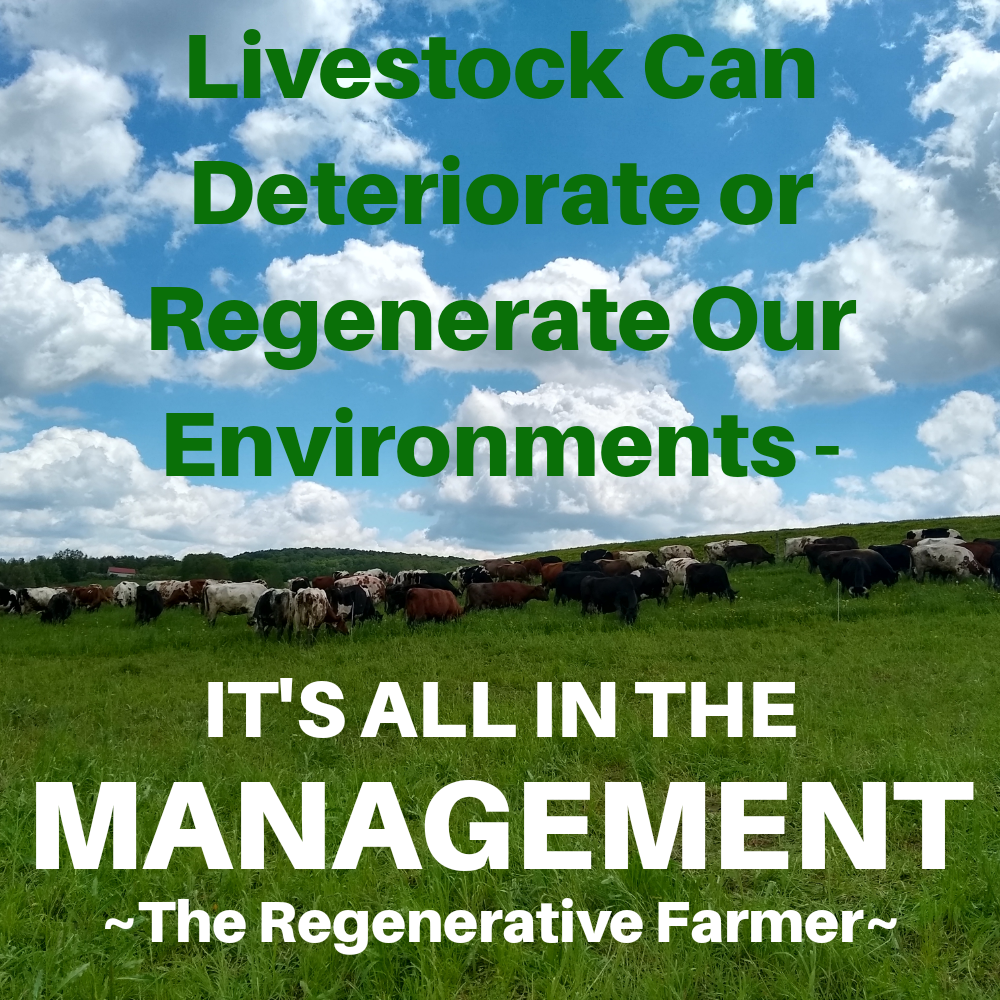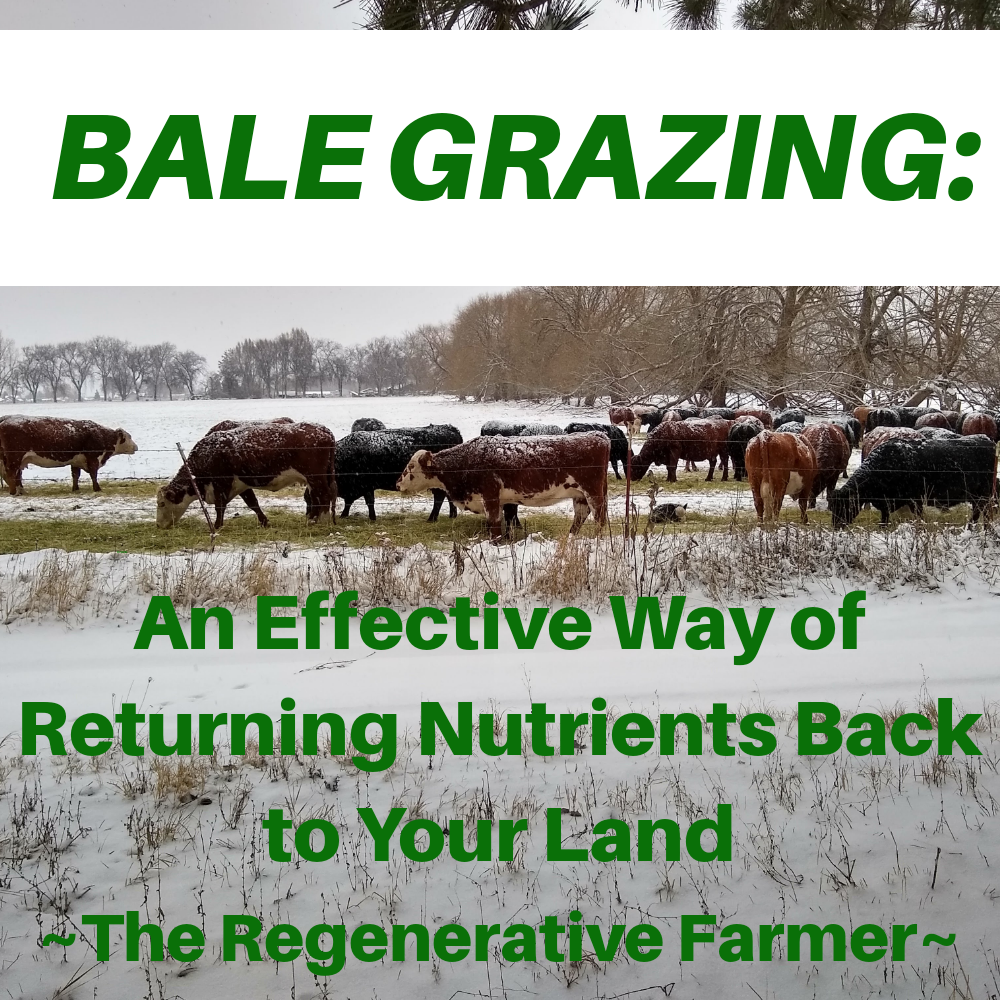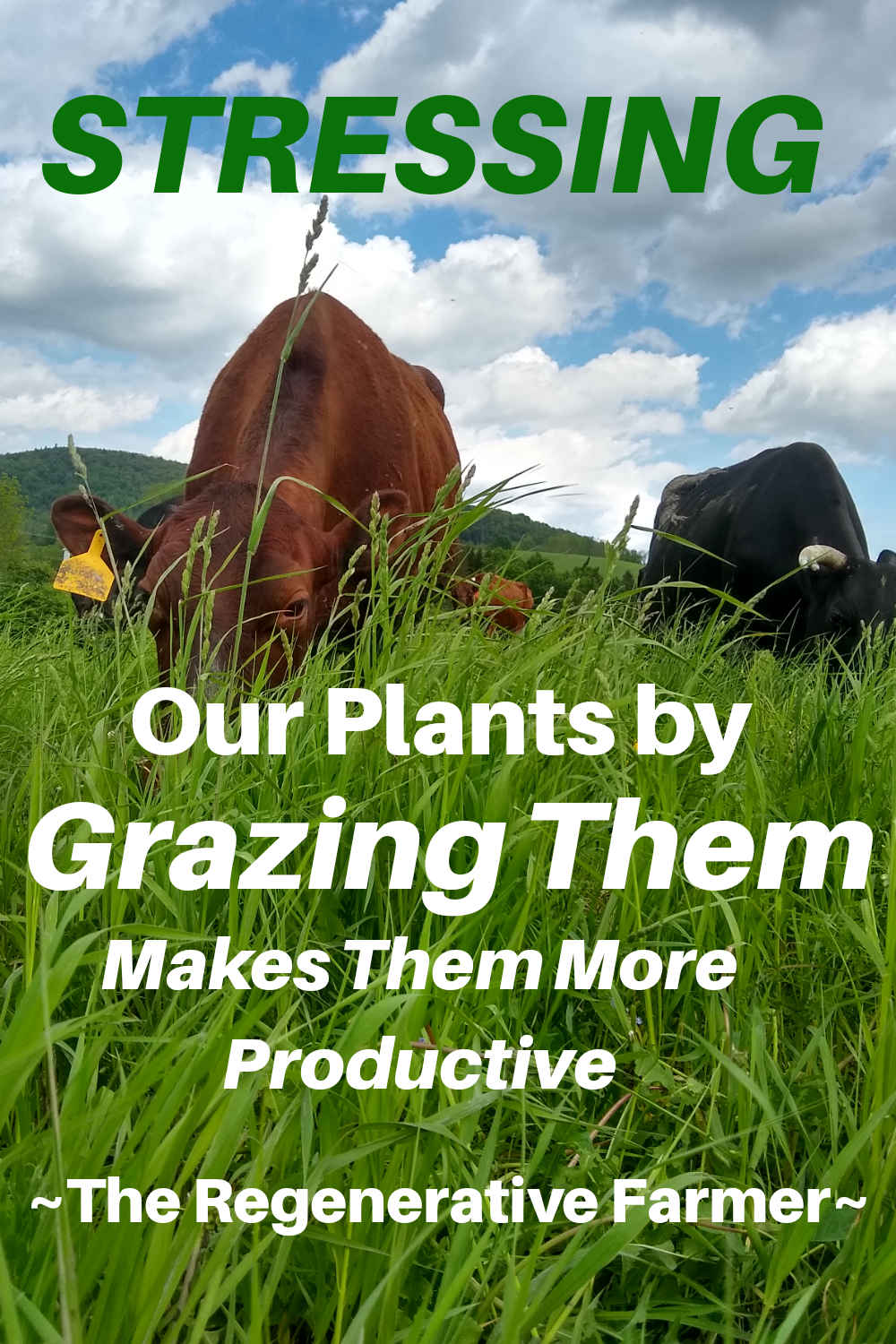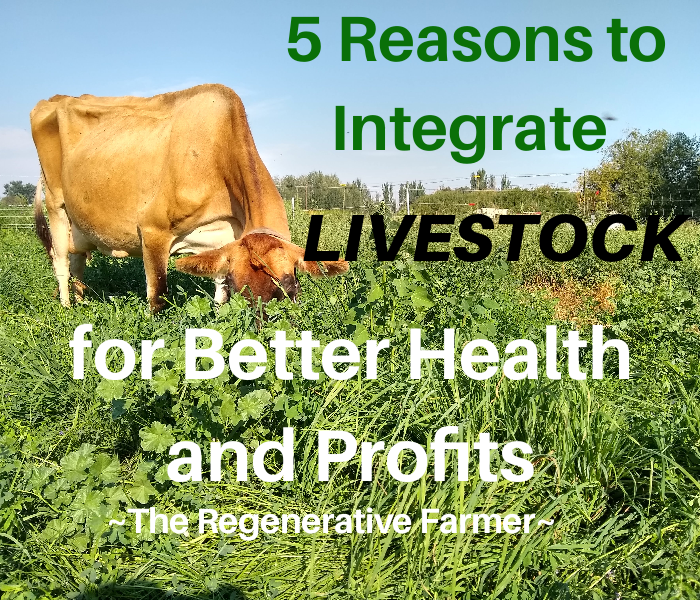You may have heard of all the bustle of integrating livestock into cropping and haying operations, or using livestock as a tool to regenerate degraded landscapes, especially by advocates such as Allan Savory, Gabe Brown, Ray Archuleta, and others.
A bit from the orthodox way it’s been done the last few decades, right?
I’ve got big news for you though – they’re onto something.
AND IT’S ALL IN HOW THE ANIMALS AND LAND ARE MANAGED. MANAGEMENT IS THE KEY FACTOR IN RUNNING LIVESTOCK!!
After 28 years of trial and error, Gabe Brown has found out tried and true practices that make money farming while increasing the overall health of his farm’s ecosystem.
In 1993, the NRCS measured that it took an hour for half an inch of water to infiltrate through the soil. (This was the starting point of when Gabe began to build his soil.) In June of 2009, 13 inches of rain pounded the Brown’s farm in less than 6 hours. The following day, his soil was wet – but there was no standing water. Two days after the storm, Gabe could drive nearly anything he wanted across that ground without creating ruts. His neighbor, however, lost his crop to erosion.
In 2011, the NRCS returned to Brown’s ranch and measured that 8 inches of rainwater could infiltrate in an hour. In 2015, it took under 30 seconds to infiltrate 2 inches.
(Montgomery, David. Growing a Revolution: Bringing our Soil Back to Life. David Montgomery. New York: W.W. Norton and Company, pgs 222-223.)
What kind of voodoo does Gabe practice to achieve those results??
For one thing, he practices the 5 principles of soil health, (check out my article The 5 Crucial Principles of Soil Health to learn more about them) and the fifth principle is to integrate livestock.
A long held belief has been that livestock are one of the #1 causes of environmental deterioration.
And that CAN be true… depending on how we manage them.
Livestock are one of the four basic tools that us as humans use to control our environment. (The other tools are fire, rest, and technology.)
Like all tools, we can use livestock to either deteriorate, or regenerate our environments.

Therefore, the MANAGEMENT of livestock is imperative as to what you’re trying to accomplish and what level of success you’ll achieve.
(I cannot stress enough- MANAGEMENT, MANAGEMENT, MANAGEMENT!!)
In this article, you will learn how properly integrating livestock can create better yields, profits, and overall productivity on your operation.
1. Livestock Spread Nutrients and Build Fertility.
Livestock manure is one of the most valuable sources of fertilizer for soils – and in today’s conventional farming, one of the least utilized.
In fact, if we stopped raising animals in Confined Animal Feeding Operations (CAFOs) and put them BACK onto the land the way nature intended, and if we could capture and recycle all of their manure, we could match >85% of crop phosphorus removed from cropland soils during harvest.
That means 85% less phosphorus fertilizer that we as crop farmers would have to purchase.
Livestock are constantly cycling nutrients from their feed and passing some through their urine and manure, which feeds the microbiology that is so essential for plant health and performance.
The benefits have been clearly shown in numerous field tests and trials…and in fact, some studies have even suggested that livestock manure is superior in contrast of compost and conventional N as a fertilizer.
(Montgomery, David. Growing a Revolution: Bringing our Soil Back to Life. David Montgomery. New York: W.W. Norton and Company, pgs 222-223.)
Integrating ruminants on an operation gives a boost of microbial livestock as well.
Hold it right there. What’s microbial livestock??
Microbial livestock are basically the critters that dwell in the soil, and without them life on earth as we know it would NOT be possible.
How is that? Microbes stabilize, aggregate, aerate, and loosen soil particles, make nutrients available to plants in a form that they can use, break down organic matter, and utilize carbon – it’s all a part of the beautiful synergy that makes our world.
Getting back to the point…ruminants need microbes to help them digest their food. Some of those same microbes in the rumen are also the same microbes that dwell in the soil – putting two and two together, some microbes leave the rumen through the animal’s excrement, boosting microbial populations in the soil.
(Ruechel, Julius. Grass-Fed Cattle, pgs 12-14, Storey Publishing.)
2. Returning Livestock to Cropland Enhances the Mineral Cycle.
Grazing livestock on cropland stubble was common practice before agriculture began to grow industrial.
So why should we integrate them back onto our fields?
As our current standard production model goes, we are constantly shipping off minerals that are essential for our plant’s productivity. We try to make up for these losses by applying large amounts of fertilizers (which are actually just harming us more).
As previously mentioned, livestock are great tools to increase fertility and spread nutrients. Instead of penning up livestock in confined operations, where their manure is a waste and a pollutant, graze them back on the fields and save your bank account from a fertilizer bill this year.

Bale grazing is another way to return nutrients to your land with livestock. Any leftover hay or feed that the animals do not eat is not a waste; it will build up your organic matter and feed your soil microbes (which the animals [if ruminants] have already done a spectacular job of restocking the populations), which will in turn feed your plants.
(This is an excellent article from Graze Magazine to look into if you’re interested in improving your soil with bale grazing: http://www.grazeonline.com/buildtopsoilbalegrazing . I also discuss more details of bale grazing in my article, How to Profitably Survive a Drought.)
If you want to see even better results using livestock, you could take it a step further and plant cover crops during the growing season and graze it at high density, as Gabe Brown has been demonstrating.
Reason #3 explains some of the benefits of doing this.
3. Plant Productivity Increases with Livestock.
For the reasons already mentioned, your plant productivity increases using livestock. They fertilize with high-quality manure and leftover feed as well as boost microbial populations (if they’re ruminants).
There is another reason why plant productivity increases using animals, and that’s the power of well-managed grazing.
How does grazing improve your plants’ productivity?
In nature, everything is intertwined. Any changes to one specific part of a whole will affect the whole in its entirety. (This is why it’s so critical that we make our decisions based on a holistic viewpoint, using Holistic Management.)
Therefore, grazing your plants will affect the soil health, which affects the water, mineral, and energy cycles, which affects your plant’s health, which affects our livestock’s and our own health. It’s all connected.
Here’s a little bit of science as to why grazing improves your soil and plant performance:
When plants are grazed, they consider the removal of their leaves equivalent to a wound. In order to replenish the lost growing material, they signal to microbes for the necessary nutrients that they need to heal.
The microbes collect the nutrients (from materials such as organic matter, rocks, etc.) and make them available to the plants in a form that they can utilize. In return to the microbes, plants leak out a carbon rich compound that the microbes then feed on.
Those microbes aggregate and stabilize soil particles and create humus, which allows for greater water infiltration and storage in the soil. Once the microbe populations reach a certain density, they begin quorum sensing, which induces the growth, health and defense of the plants supplying them with exudates.

Stressing our plants by grazing them makes them more productive; the more carbon they take from the atmosphere and exchange for nutrients, the better the soil quality is to sustain life.
Of course, this is assuming that this is under well managed grazing, where the animals are stocked at high density in smaller paddocks for a brief period of time, and the plants are given an adequate amount of time to recover. Timing is crucial for successful results in grazing.
To learn more about well-managed grazing to improve the health of your land and increase your profits, look into Sarah Flack’s “The Art and Science of Grazing,” and Allan Savory’s “Holistic Management” (the 3rd edition is best).
4. Degraded Landscapes are Restored With Livestock.
Yes, livestock can restore deteriorated environments to a state of environmentally sound health.
Like I’ve already stressed, it’s all how you manage the system.
As Allan Savory has pointed out in Holistic Management, the reason that animals are blamed for environmental deterioration is because of our misunderstanding of how our environment functions.
One of the greatest misunderstandings has been that we treat both brittle and non-brittle environments in the same manner.
A brittle environment is one that does not have consistent moisture throughout the growing season, whereas a non-brittle environment is the opposite. (It’s not about how much precipitation you get – it’s about how frequently it occurs.)
Brittle and non-brittle environments do not respond to the same management and end up with the same results, as shown below.
Some of the characteristics of a brittle environment are:
- Infrequent precipitation distribution throughout the growing season
- Slow decay of dead plant material
- Standing plant material oxidizes
- Long periods of rest with no high-animal density desertifies the land
- Understocking livestock desertifies land
- Overgrazing plants causes more exposed soil
- High stocking density with an adequate recovery period regenerates brittle environments
While some of the main attributes of a non-brittle environment are just the opposite:
- Frequent precipitation throughout the growing season
- Rapid decay of dead plant material
- Standing plant material is rapidly broken down by microorganisms
- Long periods of rest tends to advance a non-brittle environment to woody brush and tree growth
- Overgrazing will harm plant growth but still not expose soil (due to the close plant spacing)
- High stocking density increases the health and ecosystem function in non-brittle grasslands (woody growth is inhibited by the short duration grazing)
This is why, in our efforts to preserve our rangelands, national parks, etc., that things have only continued to deteriorate in brittle environments.
Livestock are key to reversing the desertification process.
When you mob graze animals together in a tight herd, you change their behavior. It’s like taking you from a dining room with two guests into a packed buffet. Where you would normally feel reserved and not in much of a hurry to serve yourself with the two guests, you would protect your right to stay in line and help yourself more aggressively in the buffet line.
The same is true for herding animals. In the nature, herbivores in brittle environments bunch up in large numbers for safety from predators. This concentration changes the animal’s behavior; they are no longer selective about grazing plants, but rather are quickly eating what is in sight, trampling any standing plant material and manuring and urinating on the spot that they are grazing on.
After the animals have been there for a short period of time, they move on to graze a different paddock.
Notice what a large amount of animals grazing on a small area for a short duration of time do during this process…
They are:
- Trampling standing plant material, giving it contact to the soil surface so that microbes can break it down and recycle the nutrients (this solves the issue of standing plant material in brittle environments hampering new plant growth)
- Fertilizing the soil
- Stimulating the production of plant exudates to feed microbes, which allows for greater water storage capacity and utilizes carbon
- Creating a dense sward of plants, which maintain the protective armor of the soil (preventing bare soil from eroding)
- Promoting plant productivity
- Preventing overgrazing and understocking (both of which promote poor plant production, ineffective mineral, energy, and water cycles, and bare/eroding soil)
This Holistic Planned Grazing has proven highly effective in restoring environments across the brittleness scale, from national parks to ranches to croplands.
Can you see how important livestock are to maintaining the health of our brittle environments and grasslands?
For more on Holistic Management and Planned Grazing, look into Allan Savory’s Holistic Management (again, the 3rd edition is best).
5. The Diversity Factor.
We are now at #5, my final point for why to integrate livestock into your operation for better health and profits.
The more diverse your system is, the healthier it gets.
(You’ve already seen the benefits of diversifying with livestock!)
For that reason ALONE, you should consider integrating livestock!!
Diversity also serves as a kind of insurance. If one crop is failing or doing poorly, or the market is down, the more diversity in products you have, the more likely you can make it through the tough times.
Take this, for example: I know some family friends in Central Washington State who have been in the business of growing fruit for years. One year, the frost killed the apple blossoms, and the apples were the chief source of income for their family.
The reason they were able to survive and stay in business? They had cherries on the side that made it through the spring.
Conclusion
Livestock are truly one of the greatest and most important tools that we use to manage our environment.
Locking them up in feedlots and warehouses (where they become a problem), instead of using them on our land (where they’re part of the solution), has been one of the most stupid things the human race has done.
The good news is, you don’t have to go down the same road. You CAN build health and create the quality of life that you want!
Remember that management is the key to your success!!
If you think that adding livestock to your operation (whether you’re a farmer, park manager, etc.,), is in line with your Holistic Context, then get after it!
I’m very excited for your success, my friend. I hope this piece has helped you!
Thanks again for being here today.
Isaiah

